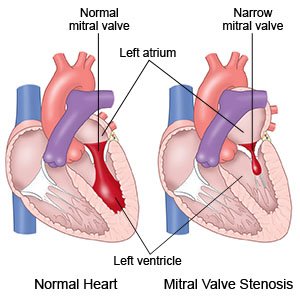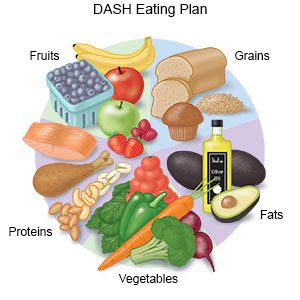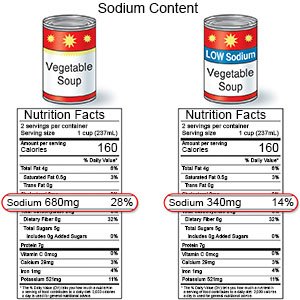Mitral Stenosis
Medically reviewed by Drugs.com. Last updated on Aug 4, 2025.
Mitral stenosis is a condition that makes your mitral valve narrow and stiff. The mitral valve is between the left atrium and the left ventricle of your heart. The valve opens and closes to direct blood flow through your heart. With mitral stenosis, your valve may not open or close properly. This causes strain on your heart muscle and decreases blood flow to your body.
 |
DISCHARGE INSTRUCTIONS:
Call your local emergency number (911 in the US) or have someone call if:
- You have any of the following signs of a stroke:
- Numbness or drooping on one side of your face
- Weakness in an arm or leg
- Confusion or difficulty speaking
- Dizziness, a severe headache, or vision loss
- You have any of the following signs of a heart attack:
- Squeezing, pressure, or pain in your chest
- You may also have any of the following:
- Discomfort or pain in your back, neck, jaw, stomach, or arm
- Shortness of breath
- Nausea or vomiting
- Lightheadedness or a sudden cold sweat
- You feel lightheaded, short of breath, and have chest pain.
- You cough up blood.
Return to the emergency department if:
- Your arm or leg feels warm, tender, and painful. It may look swollen and red.
- Your symptoms get worse.
Call your doctor or cardiologist if:
- The veins in your neck look swollen or are bulging.
- You have a fever.
- You have questions or concerns about your condition or care.
Medicines:
You may need any of the following:
- Heart medicine may be given to slow your heart rate and help your heart fill with blood.
- Diuretics are given to remove extra fluid that has collected in your heart, lungs, or legs. They are often called water pills. You may urinate more often when you take this medicine.
- Blood thinners help prevent blood clots. Clots can cause strokes, heart attacks, and death. Many types of blood thinners are available. Your healthcare provider will give you specific instructions for the type you are given. The following are general safety guidelines to follow while you are taking a blood thinner:
- Watch for bleeding and bruising. Watch for bleeding from your gums or nose. Watch for blood in your urine and bowel movements. Use a soft washcloth on your skin, and a soft toothbrush to brush your teeth. This can keep your skin and gums from bleeding. If you shave, use an electric shaver. Do not play contact sports.
- Tell your dentist and other healthcare providers that you take a blood thinner. Wear a bracelet or necklace that says you take this medicine.
- Do not start or stop any other medicines or supplements unless your healthcare provider tells you to. Many medicines and supplements cannot be used with blood thinners.
- Take your blood thinner exactly as prescribed by your healthcare provider. Do not skip a dose or take less than prescribed. Tell your provider right away if you forget to take your blood thinner, or if you take too much.
- Take your medicine as directed. Contact your healthcare provider if you think your medicine is not helping or if you have side effects. Tell your provider if you are allergic to any medicine. Keep a list of the medicines, vitamins, and herbs you take. Include the amounts, and when and why you take them. Bring the list or the pill bottles to follow-up visits. Carry your medicine list with you in case of an emergency.
Manage mitral stenosis:
- Eat heart-healthy foods. Heart-healthy foods include salmon, tuna, walnuts, whole-grain breads, low-fat dairy products, beans, and oils such as olive or canola oil. A dietitian or your provider can give you more information on meal plans such as the DASH (Dietary Approaches to Stop Hypertension) eating plan. The DASH plan is low in sodium, processed sugar, unhealthy fats, and total fat. It is high in potassium, calcium, and fiber. These can be found in vegetables, fruit, and whole-grain foods.

- Limit sodium (salt) as directed. Too much sodium can affect your fluid balance. Check labels to find low-sodium or no-salt-added foods. You can also make small changes to get less salt. For example, if you add salt while you cook, do not add more salt at the table. Ask your healthcare provider or dietitian for more ways to cut down on salt.

- Exercise as directed. Exercise will improve your heart health. Ask your healthcare provider about the best exercise plan for you. Start slowly and increase activity as you get stronger. Stop if you feel short of breath.
- Limit caffeine. Caffeine can make irregular heartbeats worse. Ask your healthcare provider about eating or drinking anything that contains caffeine. Ask him or her how much caffeine is safe for you.
- Do not smoke. Nicotine and other chemicals in cigarettes and cigars can cause lung and heart damage. Ask your healthcare provider for information if you currently smoke and need help to quit. E-cigarettes or smokeless tobacco still contain nicotine. Talk to your healthcare provider before you use these products.
- Limit or do not drink alcohol. Ask your healthcare provider if it is okay for you to drink alcohol. Alcohol can increase your risk for high blood pressure and coronary artery disease. Your provider can tell you how many drinks are okay to have within 24 hours or within 1 week. A drink of alcohol is 12 ounces of beer, 5 ounces of wine, or 1½ ounces of liquor.
- Talk to your healthcare provider about pregnancy. If you are a woman and want to get pregnant, talk to your healthcare provider. You and your baby may need to be monitored by specialists during your pregnancy.
- Ask about vaccines you may need. Certain diseases are dangerous for a person who has mitral stenosis. Vaccines help lower your risk for infections that can lead to disease. Get a flu vaccine as soon as recommended each year, usually in September or October. Your healthcare provider can tell you if you also need other vaccines, and when to get them.
Prevent mitral stenosis:
- Manage other health conditions. High blood pressure and high cholesterol levels can worsen mitral stenosis. Ask your healthcare provider for more information on managing these or other health conditions.
- Get treatment for strep throat. Strep throat that is not treated can cause rheumatic fever.
Follow up with your doctor or cardiologist as directed:
You may need to return for more tests to check your heart. Write down your questions so you remember to ask them during your visits.
© Copyright Merative 2025 Information is for End User's use only and may not be sold, redistributed or otherwise used for commercial purposes.
The above information is an educational aid only. It is not intended as medical advice for individual conditions or treatments. Talk to your doctor, nurse or pharmacist before following any medical regimen to see if it is safe and effective for you.
Learn more about Mitral Stenosis
Treatment options
Care guides
Further information
Always consult your healthcare provider to ensure the information displayed on this page applies to your personal circumstances.
